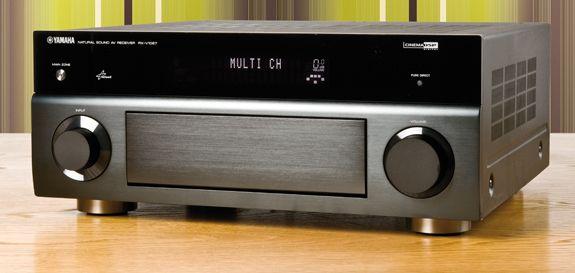Yamaha RX-V1067 review

I’m weary of annually having to upgrade my AV receiver each time the HDMI standard changes, and gaining one more HDMI input with each new model. Why don’t the manufacturers understand that all AV sources use HDMI and, at this end of the market, accept we’re likely to need more than four?
But I have now found an AV receiver that actually has more digital than analogue inputs and enough HDMI ports for all my components, including two more that can work at the same time. So with 3D video switching and audio return catered for, Yamaha’s RX-V1067 does seem quite well futureproofed.
It also has support for nine speakers and pre-outs for two subwoofers, giving you plenty of setup options. You can either bi-amp the fronts in a 7.1 system, or add a pair of front ‘presence’ speakers for a more cohesive sound using Yamaha’s many Cinema DSP modes. Note there are only seven 105W amplifiers on board, so you’ll need to add a stereo amp for the other two.
Battleship buildThe unit itself is huge and heavy, like all the best AV receivers, with a rigid chassis and newly developed heat sink that also absorbs vibration. Inside, the symmetrical power amp layout keeps the signal path as simple as possible and there’s also a Pure Direct button for cutting out the video signal for hi-fi listening.
The crisp and glossy fascia houses a large LCD display with the lower half finished in more traditional brushed aluminium. Huge volume and source select dials flank the oil-damped, drop-down flap that conceals the rest of the controls and front AV inputs. This is where the eighth HDMI input lurks.
Connectivity at the back is superb. It’s heartening to see that composite video inputs have finally given way to HDMI ports. The Ethernet port allows networking with other DLNA devices and give you access to thousands of web-based radio stations.
Yamaha has also supplied zippy onscreen graphics that now make setting up and controlling this sophisticated beast very easy indeed. The excellent YPAO auto calibration system is a godsend, too. Just plug the mic in and it’ll generate all of the sound effects needed to set the speaker levels for you. You’re free to go back and fine tune if you wish.
In plain Dolby Digital mode, this amp has instant appeal. It packs enough power to make my six M&K speakers sing and the steering of effects between them feels effortless. Using Wolfman on Blu-ray as a test disc, the Yamaha receiver sounds exceptionally dynamic, placing sound in all corners of the room and building seamlessly from rustling leaves in a midnight forest to roaring and screaming with no uncomfortable jarring at the top-end.
The balance feels lean and open with plenty of accurate treble clarity, but there’s enough low-end information to give a neutral overall sound.
The big advantage here is the speaker flexibility. I preferred to have the Yamaha switched into 7.1 mode, but using a single surround back speaker, for movie listening. However, wiring two additional speakers above and to the sides of the front pair and choosing the ‘presence’ mode has the effect of spreading the sound wider and higher, which can really enhance music. This is the 3D soundstage, to which removable stickers on the front of the unit cryptically elude.
The best option then is to add a stereo amplifier and drive all nine speakers at the same time. I was able to achieve a very convincing 9.2 home cinema from this reasonably priced receiver. And with all of the speakers in place, you can make the most of Yamaha’s numerous DSP modes, which are all sorted into Music and Movie categories.
Sonically, the Yamaha is a big success and its feature set is commendable. Yes, the lack of Wi-Fi networking is annoying, and the handset is a bit basic, but it should be able to hold its own at this price point. In fact, thanks to its futureproofed connectivity and 3D capability, it could be the last AV receiver you’ll have to buy for a few years at least.
HCC VERDICT
Yamaha RX-V1067
Price: £850 Approx
Highs: Excellent connectivity; 3D video switching; YPAO auto setup; cinematic surround sound
Lows: No Wi-Fi; basic remote control
Performance: 4/5
Design: 5/5
Features: 4/5
Overall: 4/5
Specifications
Dolby Digital True HD: yes and Dolby Digital Plus
DTS HD Master Audio: yes and DTS Neo 6, DTS ES discrete etc
THX: no Not certified by THX
Multichannel audio: yes 7 x 105W amplifiers plus 2 passive
Multichannel input: yes 7.1 channel analogue inputs
Multiroom: yes Zone 2
AV inputs: yes 4 x S-video, 7 x digital audio (4 x optical, 3 x coaxial
HDMI input/output: yes 8-in, 2-out HDMI v1.4a switching
Video upscaling: yes analogue and HDMI scaling to 1080p
Component input/output: yes 4-in, 1-out
Dimensions: 435 (w) x 430 (d) x 182(h)mm
Weight: 14.7kg
Also featuring: 3D video switching; 9-channel surround sound using front ‘presence’ speakers; YPAO mic for auto calibration; Cinema DSP sound effects; 7.2 pre-outputs; USB reader; phono input stage; works with Yamaha’s optional iPod dock; Ethernet for DLNA
 |
Home Cinema Choice #351 is on sale now, featuring: Samsung S95D flagship OLED TV; Ascendo loudspeakers; Pioneer VSA-LX805 AV receiver; UST projector roundup; 2024’s summer movies; Conan 4K; and more
|






















































